Delve deep into a mysterious world of Mayan ruins and antiquities on a journey through Central America on a Mexico Road Trip. Explore the serene beauty of the Yucatan Peninsula, Guatemala, and Belize as you traverse ancient cities, majestic temples, and remote jungles, uncovering millennia of native cultures and customs. Get ready for some unforgettable memories as you visit ancient Mayan sites and uncover the secrets of the past.
- Contents
- What to expect
- Tips & Impressions
- Overview
- Country Info
- Safety
- Getting around
- Weather
- Flora & Fauna
- Etiquette
- Itinerary
- Trip Stops
- Cancun
- Coba
- Valladolid
- Chichén Itzá
- Ek’ Balam
- Merida
- Uxmal
- Campeche
- Edzná
- Calakmul
- Palenque
- Agua Azul
- Flores – Petén, Guatemala
- Tikal (Petén, Guatemala)
- Altun Ha (Belize District, Belize)
- Tulum
- Playa del Carmen
- Rio Lagartos
- Holbox
- Closing thoughts
With scenery that ranges from lush jungles with ancient Mayan ruins poking from the tree canopy to pristine beaches and arid plains in between, the Yucatan Peninsula has it all. Here, the joyful and laid-back vibes, the colors, music, and food that make Mexico famous all around the world are showcased in their best representations.
The Riviera Maya and, in general, the Yucatan Peninsula are also the most touristic parts of the country. This means that it is very safe to drive around, and everything is generally in top condition while still maintaining its own characteristic Mexican charm.
Visiting famous sites such as Chichen Itza or the immense complex of Tikal in Guatemala, coastal towns such as Campeche, resort cities like Tulum and Cancun, and laid-back towns such as the island of Holbox or the fishing town of Rio Lagartos, this trip certainly quenches any thirst for exploring the wonderful country of Mexico.

What to expect
- Potholes, speedbumps and tarantula-ridden roads
- Amazing beaches
- Mosquito-infested jungles
- Awe-inspiring Mayan ruins overrun by iguanas
- Colorful pueblos
- Great music, excellent food, joyful people
Tips & Impressions
- Language: English is quite common, with the obvious exception of the small towns. Also, there is a sort of common understanding that somehow Spanish is simple, so the people simply talk slowly and with simpler words to let themselves be understood rather than switching to English.
- Bars and restaurants: No matter the type of place, service is always attentive and good. Mexican cuisine is world-famous, and this is the right place to completely satisfy your desire for tacos.
- Connectivity: Connectivity is pretty good all around, except in rural areas, as would be expected.
Overview
This road trip was quite an extensive one and spanned a little more than one month and around 2,500 km. It can easily be shortened by spending less time in beach towns and in resorts, and pueblos, which is what organized trips by bus usually do, with longer drives between the different sites.
However, the beauty of a road trip lies in the different environments and locations that one can see. By taking your time and stopping for a few days in pueblos or resorts on the Riviera Maya, the journey becomes definitely more enjoyable and varied, as it is easy to become quickly “saturated” by seeing only ruins every two days.
See the Itinerary below for a detailed breakdown of every location
Country Info
- Language: Spanish is the official language.
- Population: 131+ million (2019 est.)
- Ethnic Make-up: mestizo (Amerindian-Spanish) 60%, Amerindian or predominantly Amerindian 30%, white 9%, other 1%
- Religions: nominally Roman Catholic 89%, Protestant 6%, other 5%
- Government: Federal Republic.
- Currency: Mexican Peso (abbreviated as $ which can be misleading at first)
- Credit Cards: Even in some highly touristic areas such as the Riviera Mayam, cards are not always accepted.
- Electricity: Socket types A and B, 127 volt / 60 hertz
Check the Mexico page for more country general information
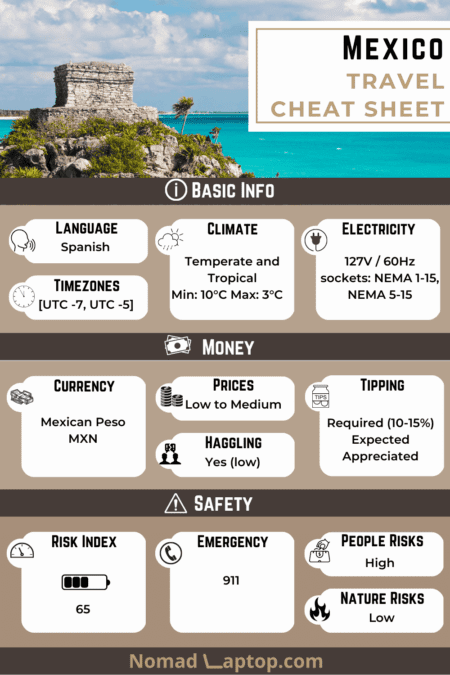
Safety
- Safety: Depending on the region, safety in Mexico can be a major issue. Regarding specifically driving around, roadblocks by corrupt police or other self-governing organized groups can create problems. On the Riviera Maya and Yucatan Peninsula in general, this is not an issue, however, as the whole region is heavily controlled and also highly aware of and watched over regarding police corruption. Major issues in the region go as far as pickpocketing.
- Natural risks: Central Mexico is more prone to earthquakes, but the coastal regions are prone to large storms and hurricanes, which regularly occur during the wet season.
- Emergencies number: 911
Getting around
- Driving is reasonable but also unhinged. In larger cities such as Cancun, the speed of cars is huge, considering the urban areas. Outside, in rural areas, there will be many sudden speedbumps (each with its own street vendor standing nearby) near small towns and settlements. These speedbumps are tall as mountains, mostly invisible, and will wreck your car if you do not spot the somewhat hidden houses and cabañas (or dogs and chickens) on the side of the road beforehand.
- Driving etiquette: The use of turn signals is somewhat “altruistic” rather than referring to the owner’s vehicle. A left-turn light indicates that the driver wants to be overtaken and sees no obstacle or danger ahead. Four emergency lights indicate (to the opposite lane of oncoming drivers) that something was spotted on the road or needs attention. Because of this, lights must be interpreted somewhat in the opposite way: if you plan on turning left, do not put your left turn light on, as other drivers will overtake you on that side.
- Driving quirks: Most roads are single-lane but there is a half-lane emergency on the right. This is where everybody drives. The center of the road is reserved for overtaking in both directions. With all sorts of vehicles on the roads, the speed differences between the fruit truck and the overtaking cars can be huge.
- Roads: The paved roads outside of the major highways are generally in bad shape, with hundreds of immense potholes that go to the center of the earth. Unpaved roads pose their own challenges depending on the season, and if traversed during the rainy season, they could be completely flooded, transformed into slimy mud, or filled with debris such as fallen trees. Also, there are frequent roadworks almost everywhere (presumably to fix the potholes), which slow down the traffic a lot. This should be kept in mind when predicting the time needed to traverse a certain area.
- Roadkill: Contrary to Australia, where this is a serious issue that needs to be accounted for when driving, I did not encounter any major wildlife on the roads. Crossing the small pueblos, there would often be dozens of dogs, each with their own character: some that would closely follow your car, others that would move out of the way, and others that would rest on the hot asphalt baking in the sun and not move no matter what. In Pueblos, it is also common to see several chickens on the side of the roads, but they have a good sense of vehicles and traffic and move out of the way unlike some other animals (I’m looking at you, Australian Kangaroos). In more remote and jungle-ridden areas such as those leading to archaeological sites, there are many signs informing about crossing wildlife ranging from monkeys, turkeys, and jaguars, but these are well aware of the dangers of the roads and tend to remain hidden during the day. Also, monkeys use the road overpass nets to cross from one tree to another. The only animals that will probably be encountered and possibly run over are the huge black tarantulas, which simply cross slowly. They can be seen from far away, which should give an idea of their size.
Check the Driving in Mexico page for more driving tips and information

Trivia pill
Spanish is not the only national language of Mexico. In fact, there are 68 other indigenous languages including náhuatl, maya, mixteco, and otomí, which are recognized as national languages.
Náhuatl for example was the language used by the Aztecs during the 14th century and is spoken to this day by around 1.4 million people in Mexico.
When it comes to Spanish though, there are over 67 million people in Mexico who speak Spanish, making up half of the world’s Spanish-speaking population.
Weather
Depending on the season, the weather on the coast can be wonderful and dry or beaten by the rain. In the central parts of the peninsula, the heat is very strong, although it is not at “Asian humidity” or “Australian sunburn” levels.
As in other regions of the tropics, seasons are split more between the rainy and dry seasons, rather than the four commonly known seasons.
Autumn and winter all the way to early spring (March, April) are the months that are favored by tourists, with temperatures remaining high and a drier climate.
Late spring, summer, and early autumn are the rain and hurricane seasons, although there can be weeks with clear skies. Prices everywhere are much lower in this period and the occasional rain also brings out the colors and “washes” away the smog from bigger cities.
Flora & Fauna
- The only major “threat” and annoyance are the mosquitoes. Western tourists can be easily identified, apart from their skin color and general cluelessness, by the utter devastation of their legs. Depending on the area, the biting mosquitoes range from minuscule insects that simply feast in swarms during the evenings to large flies that attach to your limbs and do not let go.
- Especially in the northern parts of Yucatan, the archeological sites and the cities themselves host many black iguanas.
- I need to mention, because of my dislike for them, some ultrasonic birds. Especially on the coasts, Yucatan Jays can be found everywhere. With their beautiful blue plumage and beaks perpetually tilted towards the sky, they will go absolutely ultrasonic with no warning whatsoever. Anyway, this is nothing when compared to Australia.
- See the Getting around section for details, on what can be encountered on the roads.
Etiquette
- Service, despite being excellent, is relatively slow. However, the whole region is a vacation destination and the appropriate, laid-back attitude should be embraced without going into entitled rants if something is not absolutely perfect.
- Tipping: The Propina is expected in many places that have a touristic vocation and should be around 15%. US level of tipping such as 18 or 20% is uncommon, but clearly highly appreciated.
- Society and business are highly hierarchical therefore authority must be respected at all times.
- For female travelers, Mexico has a long-standing culture of machismo. As such, it may be commonplace to receive remarks and these signs of stereotypical males should not be interpreted as harassment.
- Marigold flowers are a symbol of death and this can be observed during the Day of the Dead festivities. As such, it is not an appropriate flower gift.
Trivia pill
The modern-day Mexican flag originated in 1968, Red, white, and green are the colors of the national army of Mexico with green symbolizing hope, white standing for purity, and red representing the blood that was shed to achieve independence.
The central emblem is the Mexican coat of arms and is based on the Aztec symbol of their imperial capital Tenochtitlan. It depicts an eagle sitting on a cactus while devouring a serpent and indicates to the Aztecs that they (the eagle coming from the Sun) had found the site (the cactus) where to found their city. In later Roman Catholic interpretations, the eagle represents all that is good, while the snake represents evil and sin.
Itinerary
Trip Stops
- Cancún
- Valladolid
- Cobá
- Chichén Itzá
- Merida
- Uxmal
- Campeche
- Edzná
- Calakmul
- Palenque
- Agua Azul
- Flores
- Tikal
- Caracol
- Altun Ha
- Chetumal
- Tulum
- Playa del Carmen
- Isla Holbox
- Rio Lagartos
Cancun
Cancún
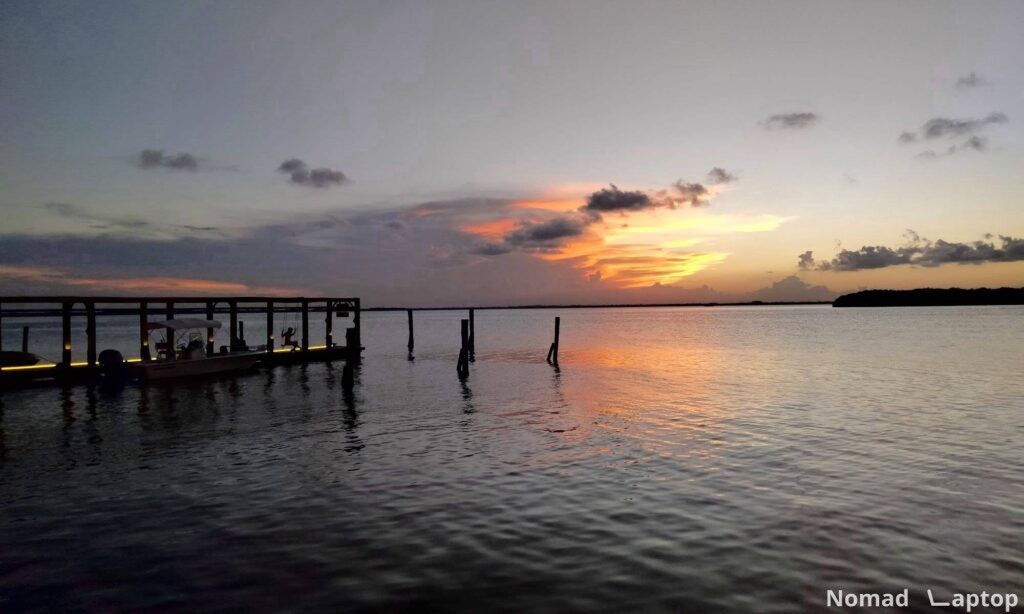
About
Cancun is one of the top travel destinations in the whole country. A recently developed city, it lies in the heart of the Mexican Caribbean. Famous for its resorts, wild nightlife that never ends, and luxury environments, the city is composed of two separate parts: the Zona Hotelera, which comprises large resorts entirely aimed at tourism, and the older town of downtown Cancun, which maintains the typical characteristics of a Mexican town.
Impressions
The hotel zone has clear American vibes and is highly touristic, with large shopping malls, high-end restaurants, and immense resorts. Downtown Cancun instead immediately strikes with a slightly more genuine and somewhat more chaotic environment.
I found this separation very striking, especially driving around, with the large coastal road in the hotel zone having high-speed traffic as they move from one large building to another and the small interconnected roads bustling with people going about their business, smaller shops, pedestrians, etc.
Coba
Cobá

About
Despite being close to the nearby complex of Chichen Itza, this site is often overlooked by passing tourists. It is clearly less impressive but this allows a nicer exploration of the ruins and the whole site. It has a wonderful character for being the only site where one can rent a bike or a bike taxi and wander on the sacbes within the jungle. This difference, coupled with the fewer visitors, also leads to fewer street vendors and a generally less chaotic experience.
Cobá hosts Ixmoja, part of the Nohoch Mul complex. At 42 m, it is one of the tallest stone-step pyramids in Mexico.
The site is famous for having an extensive network of sacbes—stone roads built to connect to various city areas. It is also much less famous than the nearby complex of Chichen Itza, thus allowing for a nicer exploration of the ruins.
Drive
140 km from Cancun on the highway. Easy peasy.
The site is easily reachable and stands about 90km east of Chichen Itza, and 40km northwest from Tulum.
Impressions
Walking within the jungle and seeing these stone monuments appear out of the canopy was wonderful and the experience was strikingly similar to Cambodia.
Valladolid
Valladolid

About
Valladolid is a large town or small city that is still relatively untouched by tourism, despite its vicinity to Chichen Itza. The town has an extensive number of cenotes – the natural sinkhole pools, most notably Cenote Zaci. The city still feels like an authentic pueblo off the beaten path but is a perfect hub for visiting the nearby sites of Ek’Balam and Chichen Itza.
Drive
Reaching Valladolid is simple as the highway passes straight through the city. It lies 60 km from the previous stop of Coba, and about 45 minutes drive from Chichen Itza.
Impressions
After the stop at Coba, I proceeded to Valladolid, where I arrived in the afternoon. Being the 3rd largest town in the Yucatan Peninsula, I was expecting a moderately large town. Not a skyscraper metropolis but at least some wide roads or houses. Instead, it is like the previous “towns” encountered on the way: dirt roads and small shacks or at best, some masses of bricks 2 meters tall, creating these “houses”.
Accommodation
Hotel Zentik Project. ($$$$$)
I booked it because it appeared to be “different”, with eccentric artwork in the rooms and the rooms being small houses or huts with their own patio and hammock. I was not disappointed in that regard. But the hotel is weird. Very weird. For example, I am no stranger to hotel policies and their general boilerplate information to sign consent to, but this was different, to say the least.
First of all, the third bullet point stated that in case of death, the luggage of the deceased would be made available in front of the bungalow room. Secondly, the hotel has a swimming pool and an underground saline cave. But another sentence prohibits going naked there. The receptionist even repeated this point when accompanying me to my room and showed me where the nudist area was, in case my nudist impulses took the better of me. Nudist area, which is simply on top of the restaurant. So basically, there are all these small bungalow-like wooden constructions and one of them is on the “rooftop” (aka 2 m from the ground), with a bunch of naked people just chilling. Weird.
When I arrived, I received the customary complimentary tequila, which at 3 in the afternoon, after not having lunch, walking under the sun to see the ruins, and driving for 4 hours, just hit like a truck.
I had my drinks in the evening next to the super chill red cat called Tequila, just occupying the biggest and most comfortable twig sofa. The checks are brought inside old books. I got mine in The Prince by Macchiavelli.
The patches of grass around do not have iguanas, but there is a particularly persistent turtle that spent a good hour climbing on top of the shell of another, trying every possible way, moving it, and burrowing under the earth to lift it, but was unsuccessful in its rapey mating attempt. So yeah, the hotel definitely has character.
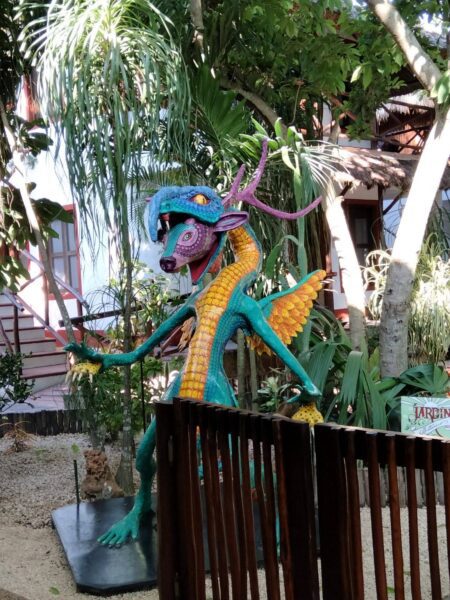

Chichén Itzá
Chichén Itzá
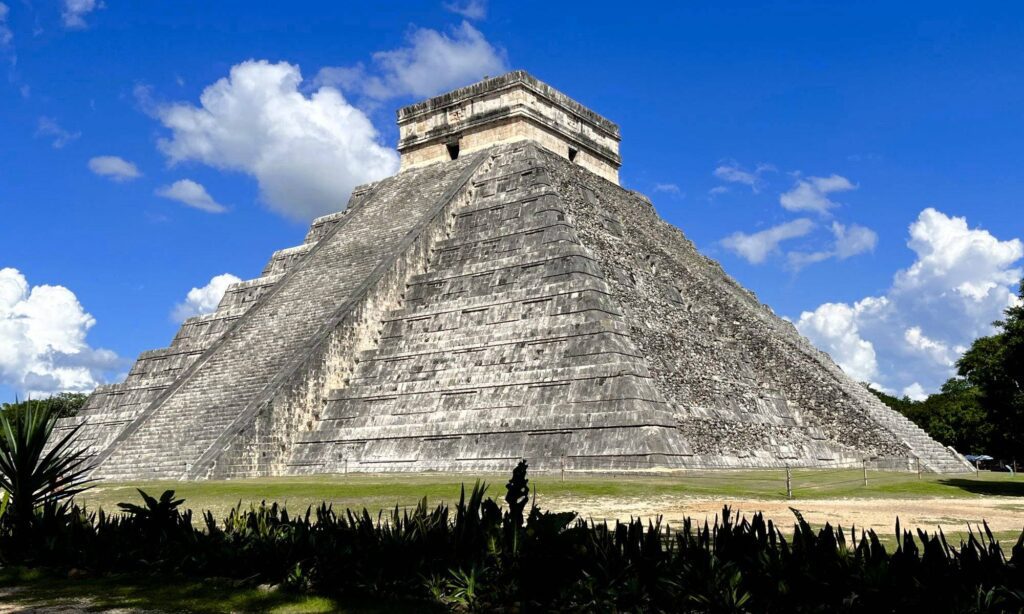
About
One of, if not the most famous, Mayan archeological sites in the whole region. Chichen Itza hosts the iconic Temple of Kukulkan and the Caracol observatory, as well as several other structures like the Temple of the Warriors. It is a relatively recent site, built starting in the late classical period (600 AD).
Drive
70 km from Valladolid
Impressions
The impression that I had was mixed. Being very easily annoyed by crowds, I knew that it would have been slightly disappointing. There were actually fewer crowds than when I went to Angkor Wat in Cambodia, but they seemed more stupid. Maybe it was the effects of the Khmer temple being still considered sacred and used by Buddhists to this day, but here my attention was constantly removed by people taking ridiculous selfies, jumping in the air, making poses, acrobatic stances, shouting, clapping, running around, etc.
Also, as expected, the roads leading up to the various temples are littered with locals selling souvenirs, water, guides, etc., like in every big tourist site, but here, unfortunately, the vendors are also allowed within the archaeological site, making the whole experience a cacophony of vendors trying to sell their crafts for 1 dollar. On top of that, every stand seems to have a dedicated person using a jaguar whistle (which imitates rather perfectly the growl of a jaguar, I guess), and this all contributed to the general noise taking away a bit of the atmosphere.
Structures
All eyes and attention are clearly on the main El Castillo pyramid or temple of Kukulkan, which, despite being relatively short, does have an imposing presence on the whole area. Its construction is heavily based on timekeeping references, as it is well known that the Mayans were maniacal (“maya-cal?”) when it came to their calendars and timekeeping. The 4 sides represent the seasons; the 91 steps climbing each side add up to 364 (+ the top central chamber); the larger steps of the pyramid are 9, and if considering the central staircase that splits them, they become 18, as the number of months in their “non-sacred” calendar. But it could also be a reference to the nine nights and the nine gods that rule them; I don’t know and will not look it up. I did not catch or see any references to the numbers 13 and 20, which were of high importance to them, but I could have probably missed some details. Disadvantages of never getting a guide and going alone, winging it with only some basic information gathered beforehand.
Speaking of calendars, the non-sacred calendar has 18 months and 20 days, which does not add up to 365. So they had an additional month made up of five “nameless days”—unlucky days where the barriers with their nine underworlds would dissolve. I really like this. We should also have this in modern times. After all, with all the leap years (and being a computer scientist, I have to add the infamous leap seconds), our Gregorian calendar is also a construction. We should have a week of “shit hits the fan” days. A sort of prolonged Halloween. It would certainly make us appreciate the passage of time more than a New Year’s Eve with wishes and partying.
The main pyramid was built not only with references to astronomical coordinates and timekeeping aspects but acoustics as well. The famous “Chichen Itza Chirp” occurs in response to loud claps done at the base of the pyramid, which echo back from the top chamber down through the stairs, resembling a ghostly bird chirp. If done repeatedly, it really sounds like birds. Because of this, one can imagine the sheer amount of noise made by large tour groups when their guide explains this to them, making the entire place a big, noisy playground mess.
Anyway, in the complex, there is also the largest and best preserved ball court in all of Mexico. The ancient Mayans were supposedly fond of playing this team game, where the rubber ball wasn’t supposed to touch the ground and could be controlled only through elbows, knees, and hips. These courts also have stone hoops on the two sides where the ball had to be thrown through using only hips. The whole court really felt like a stadium, were it not for the fact that the losing team’s captain would often be beheaded, as the game was actually used to manage disputes and a sort of confrontation between champions instead of going to war, rather than as entertainment.
The complex has two cenotes: the natural sinkholes filled with water, which were seen as sacred by the ancient Mayans and are nowadays used as refreshing pools (not these ones, of course). The sacred cenote is impressive in the vertical drop of the sinkhole and becomes even more impressive when imagining the sacrifices that used to be performed there. This whole section, with the ball court, the nearby basreliefs of skulls impaled on poles, and the sacrificial cenote, gave a sudden grim twist to the visit.
The other main structure is the temple of the warriors behind the main pyramid, and El Caracol is the observatory. Other than that, there are a dozen other structures and ruins of lesser importance and fame.
I was able to find a relatively quiet spot near the Osario pyramid in the company of yet another black iguana and a priceless moment of shade and solitude in front of the Caracol.
Ek’ Balam
Ek’ Balam

About
The ruins of Ek’ Balam are from the preclassic era, so 1000 B.C. The complex is less known but very well preserved. The main temple is Structure I, the acropolis, which holds the tomb of its ruler, Ukit Kan Lek Tok. The pyramid can be climbed and allows for a wonderful view of the surrounding jungle-covered area.
The whole site is shrouded in a thick jungle canopy, making the climb above the acropolis even more satisfying once the top of the pyramid is reached.
Drive
140 km from Cancun on the highway. Easy peasy.
Ek’Balam can be easily reached on the highway, just 30kms from Valladolid, or from Merida or Chichen Itza.
Impressions
Now we’re talking. This is what an ancient Mayan archeological site is supposed to be. Oozing antiquity from the pores of the stones.
The ruins of Ek Balam outside Valladolid are literally deserted. And overrun by lizards. At first, it was nice to see “my” totemic lizard also here. After every step I took, I would hear leaves rustling, trees scratching, and rocks being moved by these scurry reptiles.
I have to say, however, that, like in Chichen Itza, the ruins have been renovated too much. The smooth rocks kept together with concrete take away slightly from the authenticity, but I guess it’s either this or nothing at all.
Merida
Mérida

About
Merida is the capital of the Yucatan state and the largest city in the region. With influences from both Mayan culture and Spanish colonialism, it is a wonderful and busy (as well as very hot and humid) city.
Drive
120 km from Valladolid
Impressions
Driving around Merida is easy and satisfying, with the streets organized in a grid fashion, with consecutively numbered streets alternating between even and odd street numbers, allowing easy orientation within the city.
Like other Mexican cities, it hosts a large cathedral with the main town square (Zocalo), where people hang around.
The city is large and offers both high-end and luxury venues, as well as more budget-friendly locations. It hosts a large number of museums, although I personally visited only the monuments, town squares, and outdoor attractions.
Accommodation


Uxmal
Uxmal
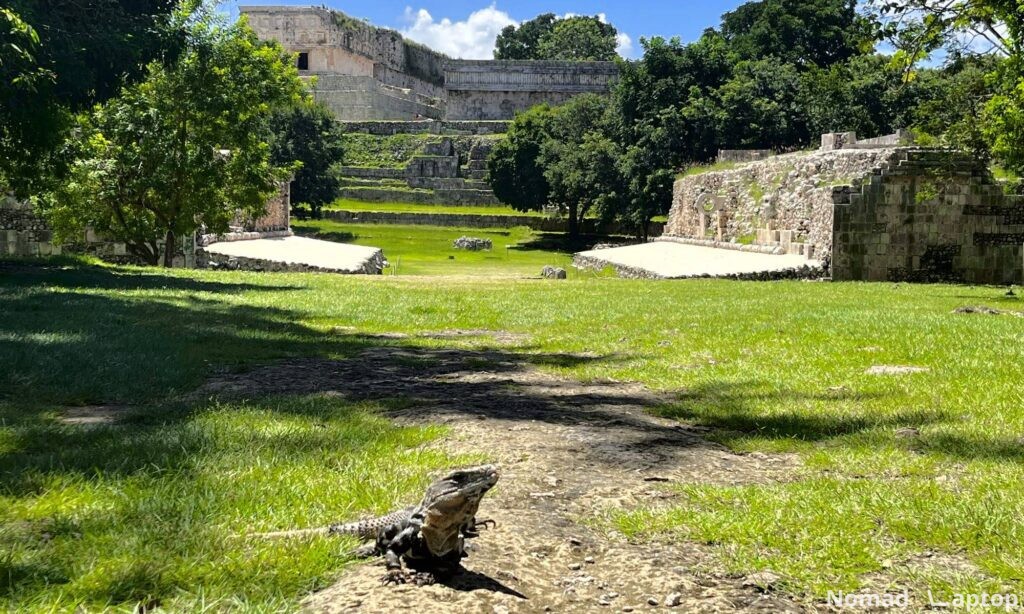
About
It is one of the most important Mayan sites, together with Chichen Itza, Calakmul, and Palenque. Because of the Puuc style of construction, the temples aesthetically differ from others. For example, the iconic stone steps are substituted with smooth and curved surfaces, like in the Pyramid of the Magician. The complex is quite extensive and apart from the main pyramid, it hosts a large ball court and the Governors Palace, which is an immense structure.
Drive
80 km from Merida
Impressions
Fortunately, when I left and headed for Campeche, the weather was bearable and I was able to go to Uxmal, one of the most important Mayan sites, together with Chichen Itza (check), Calakmul (in 2 days) and Palenque (next week).
Not only were these famous ruins within the forest allowing people to actually stop and see the buildings without being incinerated, but there were strangely very few visitors. Also, all the grass had been freshly cut, giving the characteristic wonderful smell and “golf course” landscape, which just asked people to sit on the grass and admire the ruins.
I met another huge lizard companion who was happy to take part in my pictures and enjoyed the silent walks among the ruins.
The city was built in the 8th century and there are several hills making the climb and subsequent opening on new plateaus with buildings and smaller temples a sight to behold.
That being said, after seeing four different sites, I am starting to realize that archeological restoration is done a bit too much here.
In any case, the two main structures—the pyramid of the magician, unusually containing curved sides instead of squared—and the governor’s palace dominate the landscape. There is also the ever-present ball court and an interesting house of turtles with turtle bass reliefs.
Campeche
Campeche
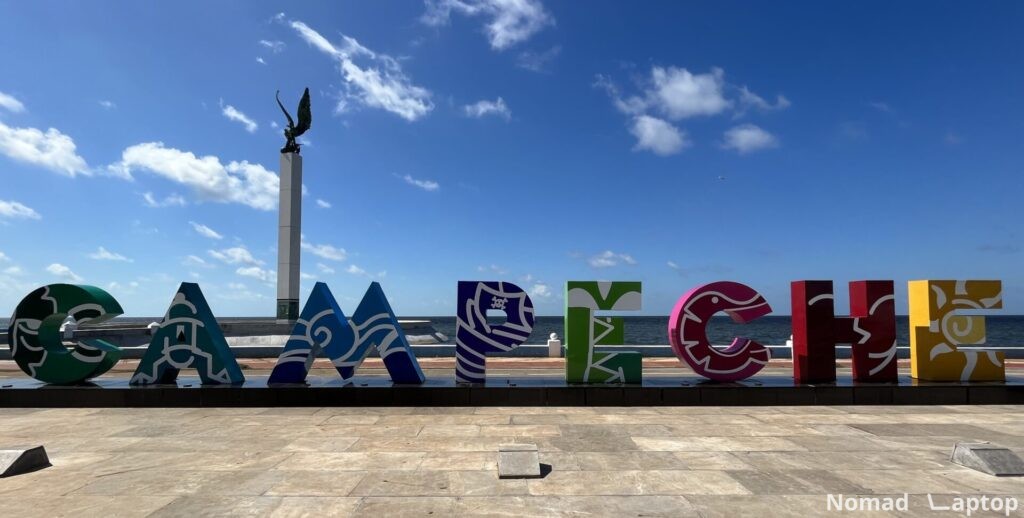
About
San Francisco de Campeche is a coastal city facing the Gulf of Mexico and the capital of the state, which goes by the same name. The town contains several old colonial buildings as well as Spanish walls and fortifications. Notable areas are the main cathedral, downtown streets leading to the shore and Plaza de la Independencia.
Drive
120kms from Merida
Impressions
After so many days in the central areas of the region with jungles, mosquitoes, and oppressive humid heat, the coastal city of Campeche feels like a breath of fresh air. Literally
Accommodation

Edzná
Edzná

About
Edzna is a wonderful and lesser-known archeological site that allows for an enjoyable visit. It is a very old site but reached its peak like many others during the classic period, when it was aligned with the powerful center of Calakmul.
The Plaza of Edzná is the most remarkable site, which hosts temples on three sides and offers a view of the surrounding city from above. Because of the region where it is located, the site is frequently flooded during the rainy season, making the place incredibly humid (and home to some of the largest mosquitoes I have ever seen).
Drive
50kms from Campeche
Impressions
Another wonderful, albeit highly restored, archeological site. Here I was literally the only visitor and also here the grass had been freshly cut, creating a wonderful visit.
Unfortunately, there is always something and the sheer number of mosquitoes was incredible. These do not seem like the typical timid but stealthy mosquitoes. They are the size of flies and just don’t care. I guess their strength is in numbers and they just swarm you and don’t let go. Their bites actually sting during their “attack”, much like small spider bites and the walk through the jungle to reach the site was simply unbearable.
Edzna was inhabited as early as 400 B.C. and remained populated until 1500 A.D. The main acropolis and the main castillo of Cinco Pisos are a wonder to behold. Much like Chichen Itza, the main plaza has been built with attention to astronomical events and acoustics, so here the shadow of the sun follows a specific illuminating path on equinoxes, and standing in the central plaza creates a chirping echo with the surrounding structures.
Calakmul
Calakmul

About
Calakmul (meaning “twin heaps”) is an immensely important site from the Classic period; it is one of the most famous sites in all Mayan culture and was a powerful city state with far-reaching influences and control. An ally city of Caracol in Belize and a rival city to Tikal in Guatemala, the complex is located within the massive 7,300 km2 surrounding jungle area of the Calakmul Biosphere Reserve.
The complex is massive, with many sacbes connecting the various areas and the highest number of stalae in the region. The main structures are the pyramid at Site I, which is the tallest step pyramid in the region, standing at 50 m, and which can be climbed. Another massive pyramid in terms of volume is Structure II.
The site is large and of huge historical importance, and because of the surrounding vast biosphere reserve, it is completely immersed in the rainforest, making it wonderful to explore.
Drive
220kms from Campeche but a very long drive on regional roads
Impressions
Reaching the ruins of Calakmul is quite a long 2-hour drive, which nonetheless was enjoyable despite some intense personal flooding moments on the way. Also, due to my lack of sleep, I was in the car at 8 in the morning so when I reached the ancient city, I was able to enjoy both the cool temperature and solitude among the ruins.
I saw several turkeys on the way, no jaguars despite the signs (which, by the way, have to be the best animal crossing signs in the whole world), and the ever-present tarantulas, calmly and slowly crossing the street without a care in the world.
Accommodation
The Hotel Puerta Calakmul ($$$$$) is the closest hotel to the ruins and stands right at the entrance of the park.
The rudimentary cabins offer everything that is needed. There are no windows and only rigid mosquito nets making it a joy a joy to sleep surrounded by the sounds of the jungle (except for the enormous moths that hammer all night on the “walls”)
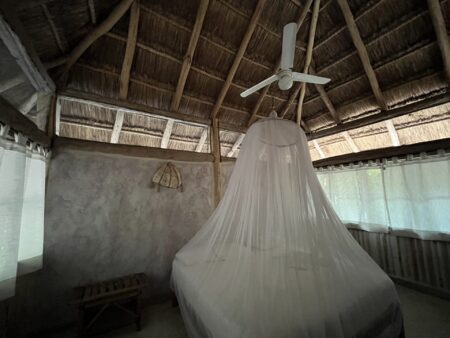
The Site
Calakmul was a major city and center of power and has ancient roots dating back to the preclassic Mayan period (so between 1000 and 400 B.C.).
The site is littered with stelae, apparently 117 scattered among the ruins and at the bases of each major structure. I was surprised to not find the ever-present ball court.
The main “attraction” is the grand plaza surrounded by several pyramids, one of which, Structure 2, is massive, measuring 120 m by 45 m, making it one of the largest Mayan structures ever built, and is absolutely immense to look at from below.
I climbed it on the side just to reach a dead end and had to literally climb on the side of the pyramid to reach another set of steep steps, which was followed by another and another. But the view was definitely worth it.
Structure 1 is slightly higher but less imposing. I climbed another large pyramid and spent quite a long time just immersed there, overlooking the vast expanses of green jungle.
Palenque
Palenque

About
An old site dating to the early classic period, it is very famous, although not as extensive when compared to Chichen Itza or Calakmul.
Palenque was reigned by Pakal, arguably the most famous king in Mayan history, who, with his 68-year reign, is one of the longest reigning monarchs in history.
Drive
370kms from Calakmul, 350kms from Campeche. In any case this is a long 4+ drive.
Accommodation
Hotel Villa Mercedes ($$$$$)
Because of the fame of the Palenque site, the city offers many resorts and hotels for the visiting tourists and also here there is a Zona Hotelera.
The Villa Mercedes is located there and offers ample parking, a nice restaurant and a wonderful swimming pool to cool off from the humid hot weather.

Impressions
I went to Palenque, another very famous archeological site in the Mayan world. The small city had a rivalry with Calakmul and was rebuilt multiple times. The whole area is scattered with 1700 temples, most of which are apparently still covered by the jungle. I skipped, as usual, the guides but could have actually taken one since there is a whole section within the jungle accessible only if accompanied.
It is an old city from the preclassic period so 400 A.D., which was reigned by Pakal, arguably the most famous king in Mayan history and who, with his 68-year reign, is one of the longest reigning monarchs in history.
I was offered four times a guide and six times mushrooms.
The site is the most immersed in the jungle I have seen until now and reminds me a lot of Cambodia but with a much more damp and humid flora. It’s beautiful but suffers from the same problem as Chichen Itza, namely souvenir vendors everywhere. Seeing the jungle colors and ruins dispersed by a rainbow of colors from all the plastic souvenirs and cloths used to showcase them takes away a bit of the atmosphere.
Agua Azul
Agua Azul

About
Close to Palenque but through winding mountain roads, the waterfalls of Agua Azul offer a wonderful refreshment to their visitors. Composed of a series of islands and drops, this long, descending stretch of the Xanil River holds several wonderful lookout points on the various island waterfalls. Some pools can also be bathed in.
Drive
Only 60kms from Palenque but through a long winding road passing through several villages. Wonderful drive but extensive.
Impressions
I went to the Agua Azules waterfalls. 70km from the city but the navigator said 2 hours. Now I know why, although I don’t know how Google knows; I guess statistics. The road is littered with dogs just sleeping under the sun on the concrete road and mad chickens just jumping out of the “sidewalk” at the last minute.
The waterfalls were wonderful. There is a nice walkway (mandatorily covered in souvenir shops) that runs along the falls and ends in a small basin where it is possible to take a swim (which I didn’t).
Flores – Petén, Guatemala
Flores

About
Flores is a small town, the capital of the Peten region and the closest city to Tikal. Facing Lake Peten, the small island of Flores protrudes on the lake, where the last Maya independent state made their last stand against the Spanish conquistadores.
Drive
350kms from Palenque crossing into Guatemala through El Ceibo border crossing. Mexico towards Guatemala receives extensive border controls and I spent 3+ hours having my papers and rental car checked
Impressions
Accommodation
Ramada by Wyndham ($$$$$) on the iconic island of Flores. The hotel is pleasant and with competitive prices and has all that can be expected by the Ramada chain hotels.
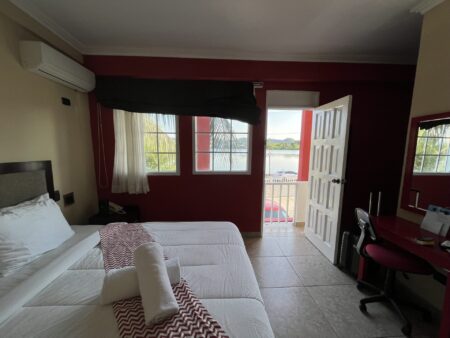
Tikal (Petén, Guatemala)
Campeche

About
The most important site in Guatemala and one of the most powerful cities in the Mayan civilization, Tikal provides the same awe-inspiring grandeur as its rival city, Calakmul. Dating to the classic period, the complex is immense and, personally, my favorite of the Mayan archeological sites.
Drive
70kms from Flores.
The Site
The city of Tikal dates as far back as 400 B.C., but like most Mayan cities, it reached its peak during the classic period (200–900 A.D.). It is commonly accepted amongst archeologists that the most significant event of the classic period was the war between Tikal and the rival, allied cities of Caracol and Calakmul, who defeated it in 562. In the post-classic period, all of these cities collapsed and it is generally considered a period of decline before the resurgence of Mayan centers of power such as Chichen Itza or the rise of other powerful Mesoamerican civilizations (i.e., Aztecs and Incas). Tikal was never discovered by Cortes during the conquista and at its height, it is estimated to have housed up to 100,000 people.
The complex has six major pyramids, altars, and stelae everywhere. There are 4 main areas to the city: the great plaza, with two pyramids overlooking it and surrounded by two acropolis; the plaza of the 7 temples, with several offspringing paths leading to smaller twin pyramid plazas; temple IV (highest and rising 70 m above ground) at the end; and the lost world, which was my favorite area, with the lost world pyramid (31 m), where I spent most of the early morning just admiring the structures rising from the jungle canopy.
Due to the rain in the middle of the morning, I also got to appreciate the sacbe—the limestone roads that are present in every Mayan city and that allow transport across the rainforest mud.
As far as fauna is concerned, there are the ever-present black howler monkeys (aka hellspawns), which howl in the morning and late afternoon, several turkeys, and white-nosed coatis (basically racoons) roaming around. No iguanas, though.
I already know that when I visit Caracol, I will either be disappointed or “against” the ancient city site just because I “have taken sides”.
Impressions
This. I’m never enthusiastic for anything, and after so many temples and ruins, I have come to realize that “there is always something” to ruin (no pun intended) the experience. But this is what I was looking for: massive in a way that inspires awe, incomprehensibly ancient in it’s roots, and clearly touristic but just enough to maintain a sense of genuineness.
There are no vendors inside the ancient city; some mosquitoes are bearable; rain is manageable. The thick morning fog wasn’t good for pictures, but it was beautiful to climb all of the major structures and stand over the rainforest with a fresh morning breeze and the sounds of nature.
Accommodation
Much like for Calakmul, I stayed in a hotel closest as possible to the ruins entrance. Here the Jungle Lodge Tikal ($$$$$) is right next to the site ticket office, within the park. The lodge is very nice in itself and has a good quality although quite because of the prime location.
Also, in many forests there are A LOT of howler monkeys, which vocalize their demon like calls in the morning, afternoon and evening. Since the hotel is right within the jungle, waking up and having dinner surrounded by the deafening howls of these primates is sure an experience in itself.
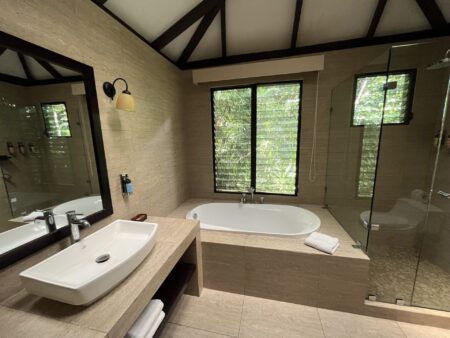
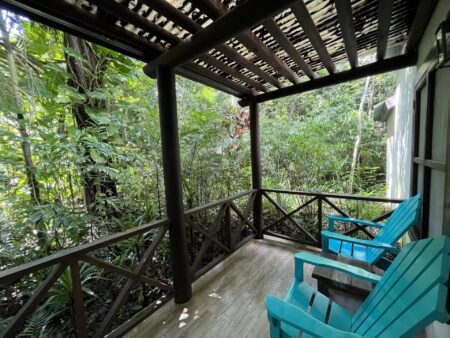
Altun Ha (Belize District, Belize)
Altun Ha

About
From here on, because of a tropical depression or hurricane, the stops were slightly ruined. The entirety of Belize was skipped and I wasn’t able to go to Caracol. In Tulum and Playa del Carmen, a lot of time was spent in the hotel surroundings because of the frequent rain showers. So until the island of Holbox, there isn’t much to say or show (and also, in Holbox, the island was completely flooded).
Drive
215kms from Tikal.
Crossing the border with Belize was a breeze compared to the Mexico to Guatemala experience.
Impressions
Accommodation
Hidden Valley Inn ($$$$$) as close as possible to the Caracol, but still about 2h drive from the park. The boutique hotel has wonderful cabins. What is most striking is the friendliness and service of the whole staff. During my stay, because of the tropical storm, I spent a lot of time in the main building and was treated with incredible attention. On the day when I tried unsuccessfully to go see the ruins the hosts packed a “small lunch” which amounted to a full blown picnic with all the necessary cutlery for the 5 courses, together with water, juice, and ice.
After having abandoned the idea of Caracol because of the weather, I moved north towards Altun Ha and stayed at the Belize Boutique Resort & Adventure Spa ($$$$$). Also here, the hosts were extremely friendly and the hotel boasts a very good restaurant.
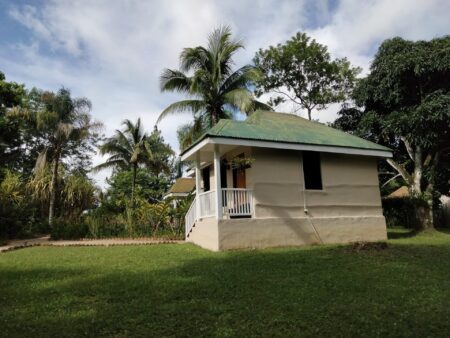


Tulum
Tulu’um

About
The ruins are unique being perched on cliffs and are one of the last built Mayan sites.
A recent tourist destination on the Riviera Maya, it has quickly developed into an important destination, having its own Zona Hotelera like Cancun, which, however, is composed of smaller boutique hotels rather than large resorts. The city is an important tourist attraction, boasting wonderful beaches, Mayan ruins, and an active nightlife.
Drive
100kms from Altun Ha to Chetumal in Mexico, crossing the border. Then 250kms from Chetumal.
Impressions
Accommodation
Having barely “escaped” the tropical storm, the weather in Tulum was always bad and I spent most of the time at the Xperience Tulum ($$$$$), which was an amazing stay. The hotel is in the city center, far from the beaches but compensates with a wonderful pool and large apartment rooms facing it.



Playa del Carmen
Playa del Carmen

About
Playa del Carmen is also a relatively recent touristic city, and much like its neighbor Tulum, it is growing at a fast pace. Known more for being more party-oriented, it has wonderful beaches with clear waters. The main tourist hotspot is Quinta Avenida, a long street that coasts the beach and holds many shops, restaurants, and bars, as well as an extensive Italian community.
Drive
50kms from Tulum.
Impressions
Accommodation
Quinta Avenida is the place to be when it comes to Playa del Carmen. The touristic and party-oriented street runs parallel to the beach and coastline and is littered with souvenir shops, restaurants, and bars. I booked my stay at Senses Quinta Avenida By Artisan ($$$$$), which is right on the street and was pleasant, despite the loud music until late at night and a weird hot tub placed right inside the room.
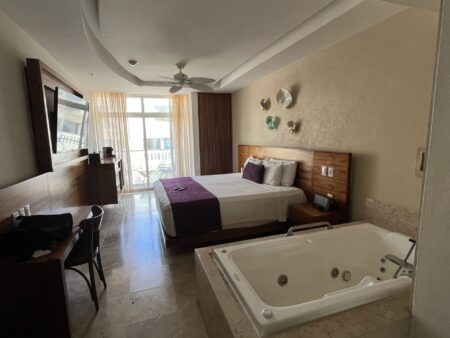
Rio Lagartos
Río Lagartos

About
A small fishing town that is quickly converting to tourism, Rio Lagartos is situated on the Ria Lagartos lagoon and is a wonderful natural reserve with many bird species. It is also known for its many alligators.
Drive
200kms from Playa del Carmen.
Impressions
Accommodation
The town of Rio Lagartos is only just starting to transition from its fishing village roots to a more tourism-oriented economy centered around visiting the river. As such, the hotels are more spartan but still very enjoyable. I booked a room at Hotel Villa de Pescadores ($$$$$), which is straight on the waterfront of the Rio.

Holbox
Isla Holbox

About
Isla Holbox is also quickly converting to tourism, but still has a rather undeveloped and natural style to it. It can be reached by ferry from the port of Chiquila and there are virtually no cars on the island. The island is within a lagoon, making its beaches muddy and full of algae. Also, it is prone to frequent flooding, which makes it very characteristic, albeit less enjoyable. Nevertheless, it is one of the few locations where sunsets can be enjoyed, making it a wonderful place to relax on the iconic hammocks on the beach.
Drive
80kms from Rio Lagartos to Chiquila, then half hour ferry.
Impressions
As anticipated, the island is completely flooded. I brought with me only a backpack and was supposed to walk for 10 minutes to my cabaña but it took me half an hour in knee-deep water, losing every 10 steps my flip-flops in the sucking mud and scrambling around the murky waters of the streets trying to recover them.
The next day I wanted to go to the northern part of the island to Punta Mosquito, a shallow area with sandy islets. There are two routes: either through the sandbags in the water some hundred meters out, or coasting the beach through the natural reserve and passing by rivers that lead into the Laguna. Since I went rather early in the morning, the tide was high, and I did not want to be bogged down walking another day in the mud, so I went with the second approach. However, after a couple of river crossings, I reached a major and deeper river. Eerily still, without any birds or markers to gauge its depth, and with another danger sign of crocodiles, which this time I took seriously.
Two days later, I moved to the opposite side of the island. 40-minute walk. So, 2 hours. This time I lost completely my flip-flops in the “shoephage” mud, but found two left-footed ones lying around, lonely orphans left behind by other unlucky souls who had also been devoured by the engulfing mud. I stayed for two nights at Hotel El Nido, near Punta Coco.
Here, the mosquitoes reign supreme and unchallenged. The hotel doesn’t have a cat but a super-fat, asthmatic French bulldog, which desperately and unsuccessfully tries to catch the geckos at night. Speaking of French, it seems there are only people from France on this island. I’m probably biased but they aren’t the best tourists and travelers in the world. Either they are lonely people who “giust wanto tak” clueless couples searching for the beach on their iPhones while standing on it, or noisy groups who just get drunk and shout putain at the sunset.
In the evenings, I would take the beaten-up bike from the hotel and cycle around either to the beach to see the sunset (Holbox is one of the few places on the Riviera Maya that faces the sunset) or to town to eat something.
This side of the island is very undeveloped from a tourism point of view and despite getting bogged down in the meter-deep “puddles” at night, it was nice to ride around in complete darkness and silence under the stars.
Another amazing stay, this time at Blue Holbox ($$$$$). The high price for the beach facing cabin was well worth it. Blue holbox is located halfway on the island, with the town center and most other hotels south, and the Punta Mosquito natural reserve north, making it a wonderful and slightly more secluded from the array of hotels to the south.
After 3 days I moved to the deep south of the island where I stayed at the boutique hotel El Nido ($$$$$) which was also very pleasant and eco-friendly.
This part of the island, beyond the city center, is still very underdevelopment from a tourism point of view and that part of the island was heavily flooded. Riding around with the hotel bike at night with no street lights within the devouring pools of mud made for quite an experience.
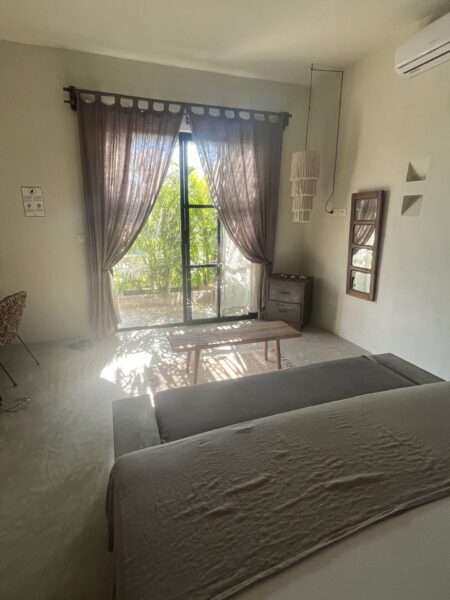
Closing thoughts
What an amazing road journey! After this one-month trip, I followed up by moving to Mexico City, down south to Puebla, Oaxaca, and Mazunte, and then back up. I just couldn’t get enough of it.
After having traveled nonstop for more than six months, homesickness creeps up no matter what, but most of all, it is easy to fall into travel fatigue. But Mexico washed away any travel fatigue that I may have experienced earlier, such as in Australia, the US, or Canada. The different scenery, warm people, wonderful towns and larger cities, and the ruins would always have something new for me. Mixing beach destinations, barren and jungle-covered landscapes, and amazing pueblos meant that as soon as I would get fatigued from a specific scenery, something completely different would be thrown at me. The food, competitive prices, warmth of people, and pristine locations Everything was just a feast to take in.




